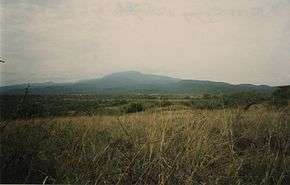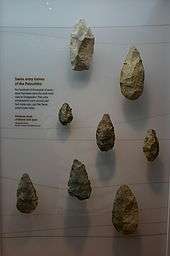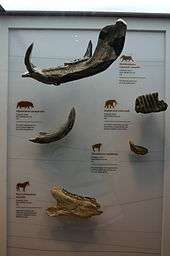Olorgesailie
 Landscape near Olorgesailie | |
| Region | Eastern Rift Valley, Kenya |
|---|---|
| History | |
| Periods | Lower Paleolithic |
| Events | Acheulean hand axes |
Olorgesailie is a geological formation in East Africa containing a group of Lower Paleolithic archaeological sites.[1] It is on the floor of the Eastern Rift Valley in southern Kenya, 40 miles (64 km) southwest of Nairobi along the road to Lake Magadi. Olorgesailie is noted for the large number of Acheulean hand axes discovered there that are associated with animal butchering.[1] According to the National Museums of Kenya, the finds are internationally significant for archaeology, palaeontology, and geology.[2]
History

The artefacts were first discovered by the British geologist John Walter Gregory in 1919,[3][4] but it was not until 1943 that excavation began in earnest under the direction of Mary and Louis Leakey, with the assistance of paroled Italian prisoners of war.[5] Work continued there until 1947. Glynn Isaac took up the excavation in the 1960s[6] for his dissertation. In the 1980s, research was continued by Richard Potts of the Smithsonian Institution in conjunction with the National Museums of Kenya.
Finds

Human tools are the most prominent of all historic items in the area. The abundant hand axes are characteristic of the Acheulean period, made by hominins between about 600,000 and 900,000 years ago[7]along what was then the shore of a now dried-up lake. Fossils of various animals have also been found, including those of extinct species of hippo, elephant, zebra, giraffe, and baboon, likely to have been butchered with the aid of the hand axes.[1][3]
In June 2003, a team led by Potts discovered a frontal bone in situ.[8] Other parts of the small skull (designated KNM-OL 45500) were found in following months. The frontal bone is 900,000 to 970,000 years old and probably belonged to Homo erectus, thereby making it the first human fossil found on the site.[9] The fossil remains were in the same stratigraphic level as two hand axes and several flakes, near dense deposits of hand axes.[1]
Geology
Preservation of the Aechulean hand axe culture was made possible by heavy falls of alkaline ash from volcanoes near the site; volcanoes that were active at the time. Mounts Suswa and Longonot are volcanoes and their vents are likely to have contributed to the ash that accumulated in the Olorgesailie basin. Subsequent sedimentation covering the site has preserved the fossils and created a stratigraphy which helps age determination.[2] Existing temporary lakes and swamps give evidence of a humid climate during the middle Pleistocene. Sediments left by the lake cover an area of 50 square miles (about 130 square km).[2] Of the artefacts, 99% were made from locally derived lavas, particularly trachyte, although small amounts of quartzite and obsidian have been found, indicating a transport over 16 to 40 km.[10]
Getting There
The site is 2 hours drive from Central Nairobi. The route goes through the C58 Magadi Road, which can be taken from the junction of Langata Road. Past the townships of Ongata Rongai and Kiserian the C58 rounds off the Ngong Hills and plunges into the Rift Valley. Note this section of road is fairly narrow and there are patches which are pot-holed. Past the township of Kisames and through the unpopulated stretch coming to the 50 km mark to Magadi is the turn-off into the site. Note that the site is 1 km inland from the C58 and the access track requires a 4-wheel drive vehicle particularly in wet conditions.
References
- 1 2 3 4 "Olorgesailie – Stone Age Site in Kenya". About.com. Retrieved 1 March 2009.
- 1 2 3 "Olorgesailie". National Museums of Kenya. Retrieved 1 March 2009.
- 1 2 "So much to see at Olorgesailie". Daily Nation. 28 February 2009. Retrieved 28 February 2009.
- ↑ Willoughby, Pamela R. (2007). The Evolution of Modern Humans in Africa: A Comprehensive Guide. Lanham, MD: AltaMira Press. ISBN 0-7591-0119-1. p. 55
- ↑ Nicholls, Christine Stephanie (2005). Red Strangers: The White Tribe of Kenya. Timewell Press. ISBN 1-85725-206-3. p. 231
- ↑ Oliver, Roland Anthony (2000). The African experience: from Olduvai Gorge to the 21st century. Boulder, Colo.: Westview Press. ISBN 0-8133-9042-7. p. 23
- ↑ Bethany A. Bye; Francis H. Brown; Thure E. Cerling & Ian McDougall (17 September 1987). "Letters to Nature – Increased age estimate for the Lower Palaeolithic hominid site at Olorgesailie, Kenya". Nature. Retrieved 28 February 2009.
- ↑ J. Cela-Conde, Camilo; Conde, Camilo Josڴae, Cela; Ayala, Francisco José (2007). Human Evolution: Trails from the Past. Oxford: Oxford University Press. ISBN 0-19-856780-4. pp. 212–13
- ↑ "First Human Fossil Found at Olorgesailie (Kenya) Field Site; Smithsonian Scientist Makes Dramatic Discovery" (PDF). Smithsonian National Museum of Natural History news release. 1 July 2004. Retrieved 1 March 2009.
- ↑ Potts, R. 1994. Variables versus models of early Pleistocene hominid land use. Journal of Human Evolution, 27, 7–24.
Bibliography
- Isaac, Glynn Llywelyn; Isaac, Barbara (1977). Olorgesailie: Archeological Studies of a Middle Pleistocene Lake Basin in Kenya. Chicago: University of Chicago Press. ISBN 0-226-38483-7.
Coordinates: 1°34′40″S 36°26′46″E / 1.577878°S 36.446228°E